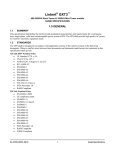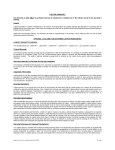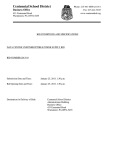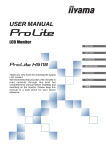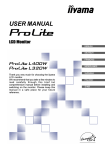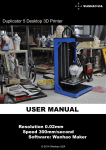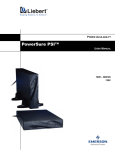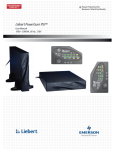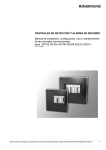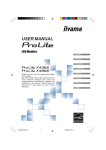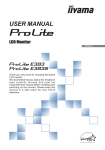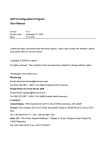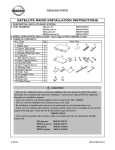Download Centennial School District
Transcript
Centennial School District Phone: 215-441-6000 x3007 Fax: 215-441-5105 www.centennialsd.org Business Office 433 Centennial Road Warminster, PA 18974-5455 BID CONDITIONS AND SPECIFICATIONS UNINTERRUPTIBLE POWER SUPPLY BID BID NUMBER 2012-33 Submission Date and Time: May 25, 2012, 1:30 p.m. Bid Opening Date and Time: May 25, 2012, 1:30 p.m. Destination for Delivery of Bids: Centennial School District Administration Building Business Office 433 Centennial Road Warminster, PA18974-5455 CENTENNIAL SCHOOL DISTRICT Administration Building Warminster, PA 18974-5455 Bid Number 2012-33 UNINTERRUPTIBLE POWER SUPPLY BID May 2012 The Centennial School District (CSD) is soliciting bids on a project to provide uninterruptible power supply (UPS) units to serve the data closets in a number of District buildings. This capability, provided by battery operated units as specified below, will maintain power in the event of a power outage until generators located at each building can begin providing replacement power. Therefore, the duration during which time these UPS units will be providing power is estimated to be 10-15 seconds. The units will be delivered to one location and will be installed by Centennial personnel. The District is asking for respondents to provide an installation bid cost as an option. 1. Sealed bids for furnishing the Centennial School District with UPS systems shall be in the hands of Mr. Christopher Berdnik, Chief Financial Officer, Administration Building, 433 Centennial Road, Warminster, PA 18974-5455 on or before 1:30 p.m., May 25, 2012 and plainly marked on the envelope "Uninterruptible Power Supply Bid No. 2012-33". 2. Bids will be opened on May 25, 2012 in the Centennial School District Business Office, Administration Building, 433 Centennial Road, Warminster, PA 18974-5455 beginning at 1:30 p.m. 3. Each bid totaling $10,000 or more must be accompanied by a Certified or Bank Issued Check or Bid Bond, made payable to Centennial School District, in the amount of 10% of the total bid as a guarantee of successful completion of the contract. All checks submitted with bids will be held uncashed and returned to all unsuccessful bidders when bids are awarded. 4. Centennial School Board reserves the right to waive any or all the technicalities in this bid. Bidders will guarantee the bid price will remain firm for 90 days from date of the bid opening. 5. The District reserves the right to increase or decrease quantities. 6. The Centennial School Board reserves the right to accept or reject any or all bids and to determine for itself what shall be acceptable as equals. 7. Failure to complete and return the enclosed Non-Collusion affidavit with your bid will result in disqualification. 8. Bidder agrees to adhere to Anti-Discrimination Clause included within the contents of this bid. 9. Acceptable manufacturer 9.1. Manufacturer - Liebert 9.2. System - model GXT3 9.3. Substitutions - No substitutions. 10. Rack-Tower UPS SPECIFICATIONS 10.1. SUMMARY - This specification shall define the electrical and mechanical characteristics and requirements for a continuous-duty, single-phase, solid-state uninterruptible power system (UPS). The Page 2 UPS shall provide high-quality AC power for sensitive electronic equipment loads. The UPS and battery systems will be supported by a 5 year warranty. 10.2. STANDARDS - The UPS shall be designed in accordance with applicable sections of the current revision of the following documents. Where a conflict arises between these documents and statements made herein, the statements in this specification shall govern. 10.2.1. 120 and 208V Nominal Units 10.2.1.1. UL Standard 1778, c-UL 10.2.1.2. CSA 22.2 No. 107.1 10.2.1.3. ANSI C62.41, Category A, Level 3 10.2.1.4. IEC 61000-3-2 10.2.1.5. EN62040-2 10.2.1.6. EN61000-4-2 10.2.1.7. EN61000-4-3 10.2.1.8. EN61000-4-4 10.2.1.9. EN61000-4-5 10.2.1.10. EN61000-4-6 10.2.1.11. FCC Part 15, Class A 10.2.1.12. ISTA Procedure 1A 10.2.1.13. RoHS Compliant 10.3. SYSTEM DESCRIPTION 10.3.1. Modes of Operation - The UPS shall be designed to operate as a true on-line double conversion system in the following modes: 10.3.1.1. Normal - In normal operation incoming AC power shall be fed to the input power factor corrected (PFC) rectifier that converts the AC power to DC power for the inverter. In this mode, power shall also be derived from utility power for the battery charger. The inverter shall derive DC power from either the PFC rectifier or the battery and regenerate filtered and regulated AC sinewave power for the connected load. The battery shall be charged once the unit is connected to utility power, regardless of whether the UPS is ON or OFF. In the event of a utility outage or severe abnormality (sag or swell), the inverter shall support the connected load from battery power until the battery is discharged or the utility returns, whichever occurs first. 10.3.1.2. Battery - Upon failure of utility / mains AC power, the critical AC load shall be supplied by the inverter, which obtains power from the battery. There shall be no interruption in power to the critical load upon failure or restoration of the utility / mains AC source. 10.3.1.3. Recharge - Upon restoration of utility / mains AC power, after a utility / mains AC power outage, the input converter shall automatically restart and assume supplying power to the inverter and the battery charger to recharge the battery. 10.3.1.4. Automatic Restart - Upon restoration of utility / mains AC power, after a utility / mains AC power outage and complete battery discharge, the UPS shall automatically restart and assume supplying power to the critical load and the battery charger automatically recharges the battery. This feature shall be capable of being disabled by the user. 10.3.1.5. Bypass - The integral bypass shall perform an automatic transfer of the critical AC load from the inverter to the bypass source, in the event of an overload, PFC failure, overtemperature, DC bus overvoltage or inverter failure conditions. 10.3.2. Design Requirements 10.3.2.1. Voltage: Input/output voltage specifications of the UPS shall be: Input - 120V units: 0 - 140VAC, 50/60Hz, single-phase, 2-wire-plus-ground. Page 3 Output - 120V units: 120VAC (user configurable: 110V, 115V, 120V, 127V) ±3%, 50/60Hz, single-phase, 2-wire-plus-ground. 10.3.3. Output Load Capacity: Specified output load capacity of the UPS shall be 2000VA/1800 Watts at 0.9 lagging power factor. 10.3.4. Internal Battery: Valve-regulated, non-spillable, lead acid cells. 10.3.5. Reserve Time: 2000VA minimum: 4 minutes These times shall be at full load with ambient temperature of 77°F (25°C). 10.4. Battery Recharge: The UPS shall contain a three-stage battery charger designed to prolong battery life. Recharge time for UPS internal batteries shall be 3 hours to 90% capacity after a complete discharge into full load. 10.5. Performance Requirements 10.5.1. AC Input to UPS 10.5.1.1. Voltage Configuration: The UPS shall operate at these values without drawing power from the batteries. 120VAC - Single phase, 2 wire plus ground nominal; variable based upon output loading: 1500/2000/3000VA 120VAC Models Load Transfer Voltage Comeback Voltage 90% 70% 30% 97VAC 78VAC 61VAC 104VAC 85VAC 68VAC 10.5.1.2. Frequency: UPS shall auto-sense input frequency when first powered up and shall operate within the following frequency specifications. UPS shall be capable of cold start with default frequency of 60Hz (120VAC and 208VAC units) and 50Hz (230VAC units). Once started the frequency operating window shall be 40-70Hz. Three frequency settings shall be available in the Liebert GXT3 Configuration program: Auto frequency sensing (factory default setting), 50Hz frequency conversion and 60Hz frequency conversion. 10.5.1.3. Input Power Factor: >0.99 lagging at rated load. 10.5.1.4. Input Current reflected distortion: 5% THD typical. 10.5.1.5. Input Current Ratings UPS Model # 120VAC Units 208VAC Units 2000RT 3000RT120 3000RT208 16A 24A N/A N/A N/A 12.9A 10.5.1.6. Inrush Current (initial startup, no load): The UPS shall have a maximum inrush current of 6 times the full load peak input current. 10.5.1.7. Input Line Transient Immunity: UPS shall conform to an input line transient conforming to IEEE C62.41, Category A, Level 3 tests for 120VAC and 208VAC models. The 230VAC models shall meet EN61000-4-5. 10.5.1.8. Surge Protection: MOV ratings shall be 175V, 80 Joules minimum connected L-N. 10.5.2. AC Output, UPS Inverter 10.5.2.1. Voltage Configuration - 120VAC, 50/60Hz, single-phase, 2-wire-plus-ground, configuration program selectable (110V, 115V, 120V, 127V). Page 4 10.5.2.2. Voltage Regulation: +3% steady state. 10.5.2.3. Frequency Regulation: ±5% synchronized to utility / mains. ±0.1Hz free running or on battery operation. 10.5.2.4. Frequency Slew Rate: 1.0Hz per second maximum 10.5.2.5. Voltage Distortion: <3% total harmonic distortion (THD) typical into a 100% linear load, <5% THD typical into a 100% non-linear load with crest factor ratio of 3:1. 10.5.2.6. Load Power Factor Range: The rated load power factor will be 0.9 lag. 10.5.2.7. Output Power Rating: 2000VA/1800 Watts at 0.9 lagging power factor. 10.5.2.8. Inverter Overload Capability: 105% - 125% for 5 minutes 125% - 150% for 1 minute 150% - 200% for 2 seconds >200% for 0.25 seconds 10.5.2.9. Voltage Transient Response: ±7% in line mode 0-100-0 % loading of the UPS ±7% in battery mode for 0-100-0% loading of the UPS rating. 10.5.2.10. Transient Recovery Time: To nominal voltage within 90 milliseconds. 10.5.2.11. Efficiency: ≥89% AC to AC, minimum 10.6. ENVIRONMENTAL CONDITIONS 10.6.1. Ambient Temperature Operating: The ambient temperature range, when UPS is operational, shall be from 32°F to 77°F (0°C to 25°C). There shall not be any degradation in the performance when operating in this range. Ambient Temperature Max Output Power Factor degradation @ max load 78-86°F ±5°F (26-30°C ±3°C) 87-95°F ±5°F (31-35°C ±3°C) 96-104°F ±5°F (36-40°C ±3°C) 100%-93% 92%-86% 85%-79% Storage: 5°F to 122°F (-15°C to 40°C ) 10.6.2. Relative Humidity Operating: 0 to 95% non-condensing. Storage: 0 to 95% non-condensing. 10.6.3. Altitude - 10,000 ft. (3,000m) max., without power derating when operated within the temperature specified in Section 1.4, Item A. Ambient temperature shall be derated 9°F (5°C) for each additional 1600 ft. (500m) above 10,000 ft. (3,000m). 10.6.4. Audible Noise - The audible noise of the UPS shall be: <48dBA max @ 1 meter from front and side, <48dBA max @ 1 meter from rear 10.6.5. Electrostatic Discharge - The UPS shall be able to withstand an electrostatic discharge compliant to ENC61000-4-2. 10.7. USER DOCUMENTATION The specified UPS system shall be supplied with one (1) user manual. The user manual shall include installation drawings and instructions, a functional description of the equipment with block diagrams, safety precautions, illustrations, step-by-step operating procedures and general maintenance guidelines. Page 5 10.8. WARRANTY The UPS manufacturer shall warrant the UPS against defects in materials and workmanship for five (5) years. The no-hassle replacement warranty shall include shipping to and from the customer site. All battery replacements are covered within the 5 year warranty period. Vendor will provide at least 1 spare unit to be kept on site as a backup. This unit will used to replace the failed system. When the replacement system is received, it will become the backup unit. 10.9. QUALITY ASSURANCE - Factory Testing - Before shipment, the manufacturer shall fully and completely test the system to ensure compliance with the specification. These tests shall include operational discharge and recharge tests on the internal battery to ensure performance. 11. PRODUCT 11.1. FABRICATION All materials and components making up the UPS shall be new, of current manufacture and shall not have been in prior service except as required during factory testing. All relays shall be provided with dust covers. 11.1.1. Wiring Wiring practices, materials and coding shall be in accordance with the requirements the standards listed in Section 1.2 and other applicable codes and standards. All wiring shall be copper. 11.1.2. Cabinet The UPS unit shall be composed of: input PFC converter, battery charger, input filter and internal bypass circuit; and batteries consisting of the appropriate number of sealed battery cells; and shall be housed in a rack-tower NEMA type 1 enclosure and shall meet the requirements of IP20. The UPS cabinet shall be cleaned, primed and painted RAL 7021 Black. The internal battery unit shall be shipped separately and shall be installed during the UPS installation process. Dimensions and weights shall be: Model Dimensions W x D x H, in. (mm) Weight lb. (kg) 2000RT 16.9 x 19.7 x 3.4 (430 x 497 x 85) 52 (26) 11.1.3. Cooling The UPS shall be forced air cooled by an internally mounted, continuous fan. Fan power shall be provided from the internal DC supply. Air intake shall be through the front of the unit and exhausted out the rear of the unit. 11.2. COMPONENTS 11.2.1. Input Converter 11.2.1.1. General Incoming AC power shall be converted to a regulated DC output by the input converter supplying DC power to the inverter. The input converter shall provide input power factor correction (PFC) and input current distortion reduction. 11.2.1.2. AC Input Current Limit 11.2.1.3. The input converter shall be provided with AC input current limiting whereby the maximum input current is limited to 125% of the full load input current rating. 11.2.1.4. Input Protection The UPS shall have built-in protection against undervoltage, overcurrent and overvoltage conditions including low-energy lightning surges, introduced on the primary AC source. The 120 and 208VAC models shall be able to sustain input surges without damage per criteria listed in ANSI C62.41, Category A, Level 3. The 230VAC UPS shall be able to sustain input surges Page 6 without damage per criteria listed in EN61000-4-5. The 120V, 208V and 230V models shall have circuit breakers. 11.2.1.5. Battery Recharge The UPS shall contain a three-stage battery charger designed to prolong battery life. Recharge time for the internal UPS batteries shall be 3 hours maximum to 90% capacity (full load discharge rate). There shall be DC overvoltage protection so that if the DC voltage exceeds the pre-set limit, the UPS will shut down automatically and the critical load will be transferred to bypass. 11.2.2. Inverter 11.2.2.1. General The UPS inverter shall be a pulse-width-modulated (PWM) design capable of providing the specified AC output. The inverter shall convert DC power from the input converter output or the battery into precise sinewave AC power for supporting the critical AC load. 11.2.2.2. Overload The inverter shall be capable of supplying current and voltage for overloads exceeding 100% and up to 200% of full load current. A visual indicator and audible alarm shall indicate overload operation. For greater currents or longer time duration, the inverter shall have electronic currentlimiting protection to prevent damage to components. The inverter shall be self-protecting against any magnitude of connected output overload. Inverter control logic shall sense and disconnect the inverter from the critical AC load without the requirement to clear protective devices. 11.2.2.3. Inverter DC Protection The inverter shall be protected by the following DC shutdown levels: DC Overvoltage Shutdown DC Undervoltage Shutdown (End of Discharge) DC Undervoltage Warning (Low Battery Reserve); factory default set at 2 minutes (user configurable 2 to 30 minutes). 11.2.2.4. Output Frequency The inverter shall hold the output frequency to ±0.1Hz of nominal when not synchronized to the utility/mains source. 11.2.2.5. Output Protection The UPS inverter shall employ electronic current limiting circuitry. 11.2.2.6. Battery Over Discharge Protection To prevent battery damage from overdischarging, the UPS control logic shall automatically raise the shutdown voltage setpoint; depending on output load at the onset of battery operation. 11.2.3. Display and Controls 11.2.3.1. General The UPS shall be provided with a microprocessor-based unit status display and controls section designed for convenient and reliable user operation. The monitoring functions such as status and alarm indicators shall be displayed on an LED display. 11.2.3.2. System Indicators UPS status shall be indicated by five symbols: fault indicator, AC input indicator, battery indicator, inverter indicator and bypass indicator. The Fault Indicator shall illuminate Red if the UPS has detected a fault; and shall be Off if there is no fault. Page 7 The AC Input Indicator shall illuminate Green when the utility input power is normal; shall be Off during utility failure; and shall flash when a Line-to-Neutral reversal occurs in the AC input power supply or when there is a loss of proper grounding for the UPS. The Battery Indicator shall illuminate Amber when the battery is supplying power; and shall be Off when the battery is not supplying power. The Inverter Indicator shall illuminate Green when the inverter is supplying power; and shall be Off when the inverter is not supplying power. The Bypass Indicator shall illuminate Amber when the bypass is supplying power; shall be Off when the inverter is not supplying power; and shall flash when utility power is outside specifications. 11.2.3.3. Controls UPS startup and shutdown operations shall be accomplished by the ON and OFF push buttons on the front panel of the UPS. The ON push button shall be a means to turn the UPS on and also to manually test the battery and reset active visual and audible alarms. Pressing the OFF push button once shall allow manual transfers of the load from the inverter to bypass power. Pressing the OFF push button twice within a four-second time period when the UPS is in Bypass mode shall completely shut down the UPS and its connected load in normal and battery mode. 11.3. 11.4. ON-LINE BATTERY TEST The UPS shall feature an automatic battery test with the factory default test interval set at every 2 weeks. The battery test shall ensure the capability of the battery to supply power to the inverter while loaded. If the battery fails the test, the UPS shall display a warning message to indicate the internal batteries need replaced. The battery test feature shall be user accessible by the push button on the front of the unit and with communication software. The Automatic Battery test feature shall be capable of being disabled or configured to operate every 7, 14, 21 or 28 days through the GXT3 User Configuration Program. BYPASS 11.4.1. General A bypass circuit shall be provided as an integral part of the UPS. The bypass control logic shall contain an automatic transfer control circuit that senses the status of the inverter logic signals and operating and alarms conditions. This control circuit shall provide a transfer of the load to the bypass source if available and if the inverter is capable of powering the load (i.e., if there is an overload condition, if the unit is in Manual Bypass Mode or if the voltage or frequency is out of tolerance). 11.4.2. Automatic Transfers The transfer control logic shall activate the bypass automatically, transferring the critical AC load to the bypass source, after the transfer logic senses one of the following conditions: UPS overload UPS overtemperature PFC failure Inverter failure DC bus overvoltage Once the overload condition is reduced, the load shall be automatically transferred back to inverter power. 11.5. 11.6. INTERNAL BATTERY Valve-regulated, non-spillable, lead acid cells shall be used as a stored-energy source for the specified UPS system. The battery shall be housed internal to the UPS cabinet and sized to support the inverter at rated load and power factor, with ambient temperature of 25°C (77°F) for a minimum of 4 minutes reserve time. The expected life of the battery shall be 3-5 years or a minimum 250 complete discharge cycles. The UPS units have the capability to allow the operator to replace the internal battery. OUTPUT DISTRIBUTION Page 8 Output distribution shall be integral to the UPS and located on the rear of the unit. 11.7. Model 120VAC Units 2000RT (6) 5-20R (T-Slot) COMMUNICATION OPTIONS 11.7.1. Liebert IntelliSlot® Communications The UPS shall include one Liebert IntelliSlot communication port to allow the operator to field-install an optional Liebert IntelliSlot communication card. A Liebert IntelliSlot card may be installed during any state of UPS operation (On, Standby or Off states). Available Liebert IntelliSlot options are described below. Liebert IntelliSlot Web Card (IS-WEBCARD) The optional Liebert IntelliSlot Web Card shall deliver SNMP and Web management to the UPS when connected to any 10 or 100 Mbit Ethernet network. The card shall support 10 and 100 Mbit Ethernet and shall provide for in-the-field upgrade of SNMP firmware. The kit shall include the Liebert IntelliSlot card, MIB, configuration cable and user manual. Include all coordination with the Liebert N-Froms Central Monitoring platform. 11.7.2. Any-Mode Shutdown The purpose of Any-Mode Shutdown shall be to shut down the UPS output by turning Off the rectifier, inverter and bypass so that there is no power to the loads. Any-Mode Shutdown can be operated locally and remotely, as described as follows: Local Any-Mode Shutdown can be performed by shorting Pin 1 and Pin 2 Remote Any-Mode Shutdown can be performed by a switch connected to Pin 1 and Pin 2 and mounted at a remote location. Remote Power Off shall be performed either by NO or NC contact of Any-Mode Shutdown, depending on the settings in the configuration program. A current-limited source (+12VDC, 50mA) shall be available from the UPS. The connection to the UPS for remote connection shall be via terminal block connector. Any-Mode Shutdown wiring shall conform to all national, regional and local wiring regulations. 11.7.3. Battery Mode Shutdown Battery Mode Shutdown shall permit shutting down the UPS by turning Off the rectifier, inverter and bypass so that there is no power to the load when the UPS is On Battery. Battery Mode Shutdown can be performed locally or remotely: Local Any-Mode Shutdown can be performed by shorting Pin 3 and Pin 4. Remote Any-Mode Shutdown can be achieved by a switch connected to Pin 3 and Pin 4 and mounted at a remote location. 11.7.3.1. On Battery On Battery signal shall be a Normally Open (NO) dry contact. When the UPS is supplying output power from the battery this dry contact shall be closed. 11.7.3.2. Low Battery Low Battery signal shall be a Normally Open (NO) dry contact. When the UPS is supplying output power from the battery and has reached the Low Battery Warning time selected in the configuration program, this dry contact shall be closed. The rated values for the dry contacts shall be: Rated Voltage: 5V Working Voltage Range: 4.5-10V Rated Current: 30mA Page 9 11.8. LIEBERT GXT3 CONFIGURATION PROGRAM An included Microsoft® Windows®-based (Windows 95 or later) Configuration Program and cable shall allow configuration of UPS features and operating parameters to meet specific application requirements, if required. Options that are configurable via this program shall include: Select one of five input/output voltages to match voltages found around the world. Enable / Disable Auto-Restart. Disable the Line-Neutral-Reversal/Missing-Ground receptacle wiring alarm. Select frequency converter operation with a fixed output frequency of 50 or 60Hz. Set the Low Battery Warning alarm time from 2 to 30 minutes. Disable the Auto-Battery test. Set the Auto-Battery test to 7, 14, 21 or 28 days. Select the number of external battery cabinets connected to the UPS to adjust the remaining runtime calculations reported by the UPS Liebert software products. 12. Critical Infrastructure Management System 12.1. OVERVIEW The Critical Infrastructure Monitoring System shall be Liebert Nform as manufactured by Emerson Network Power, Liebert Corporation. No substitutions will be accepted. The Critical Infrastructure Management software shall centrally monitor and manage distributed equipment using the customer’s existing network infrastructure. The system shall provide the Critical Infrastructure Management and Monitoring for Air Conditioning (CRAC) systems, Uninterruptible Power Supply (UPS) systems, Power Distributions Units (PDU), Static Transfer Switches (STS), Direct Current Power Systems (DC), Power Distribution Strips (PDU), Alber Battery Monitoring, Rack Enclosure Monitoring, Leak Detection Systems and other critical infrastructure systems as specified. The system shall have an architecture that allows up to 130 managed devices, including Liebert and third-party devices, in a single-server installation. 12.1.1. SYSTEM REQUIREMENTS 12.1.2. All material and equipment used shall be standard components, regularly manufactured and available and not custom-designed especially for this project. All systems and components shall have previously been thoroughly tested and proven in actual use prior to installation on this project. 12.1.3. The manufacturer will furnish or supply a site-specific Critical Infrastructure Management software system based on customer requirements. The system must be a software-only solution; no substitutions will be accepted. 12.1.4. The system architecture shall consist of network interface cards that will be installed in all critical infrastructures that at a minimum support HTTP and SNMP simultaneously. 12.1.5. The system shall receive SNMP traps from managed equipment and display the alarm notification in a graphical user interface. 12.1.6. The system shall be based on SNMP Open Protocols and integrate seamlessly with Emerson Network Power, Aperture® software suite and Network Management Systems. 12.1.7. Open protocol support shall include: HTTP(s) TCP/IP/v4, TCP/IP/v6 SNMP v.1, SNMP v.2 12.1.8. The system will have the capability of being remotely monitored and managed 24 hours a day, 7 days a week by the manufacturer. 12.1.9. The system shall have the ability to be deployed world-wide. 12.1.10. The system shall operate as a client-to-server application. 12.1.11. The Web interface of each managed device shall integrate directly into the system. Page 10 12.1.12. The system shall support Enterprise level databases including Microsoft SQL™. 12.1.13. The system shall support exporting of all recorded parametric trend data. 12.1.14. The system shall operate on a server defined by the customer. Specific server brand or function is not permissible. 12.1.15. The system shall support virtual server environments by default. 12.1.16. The system shall include at no additional cost one (1) year of Software Assurance. 12.2. PROFESSIONAL SERVICES - SOFTWARE INTEGRATION SERVICES STARTUP (SIS STARTUP) A factory-trained Infrastructure Management Technician shall perform the following installation, activation, configuration, verification and on-site training: 12.2.1. Installation 12.2.1.1. Full server and client installation of Critical Infrastructure Management Software on customer-designated servers and workstations. 12.2.1.2. Verification of installation per manufacturer’s instructions. 12.2.2. Activation 12.2.2.1. Set up access to the online software assurance portal with full activation and registration. 12.2.2.2. Set up Administrator account. 12.2.2.3. Register all license keys. 12.2.3. Configuration 12.2.3.1. Install license keys. 12.2.3.2. Discover and configure managed devices. 12.2.3.3. Set up notifications and actions. 12.2.4. Verification 12.2.4.1. Test communication with managed devices. 12.2.4.2. Generate test alarms from managed devices. 12.2.4.3. Test notifications to active e-mail accounts and mobile devices. 12.2.5. On-Site Training Comprehensive training on the Critical Infrastructure Management system that includes the following: 12.2.5.1. User account administration 12.2.5.2. Device operation and management 12.2.5.3. Event management 12.2.5.4. Real-time monitoring and trend analysis 12.2.5.5. Troubleshooting and diagnostics 13. If there are any questions concerning item description, quantity or other aspects of these specifications, please call Bob Reed at (215) 441-6000, ext. 11051. 14. Bidder should provide at least five installation references of comparable systems. K-12 references located in southeastern Pennsylvania are preferred. References should include institution name, address, contact name, and telephone number. 15. Please provide one original on paper, one paper copy, and an electronic copy of your proposal. Page 11 UNINTERRUPTIBLE POWER SUPPLY BID Bid Number 2012-33 Centennial School District Business Office, Administration Building 433 Centennial Road Warminster, PA18974-5455 May 25, 2012 We propose to furnish Liebert System - GXT3 UPS power supplies as per the specifications contained in the above referenced Bid: Equipment: Liebert System - GXT3 w/ 5 year warranty (including the battery): Each $___________________ x 45 = Total #1 $___________________ Critical Infrastructure Management System installed w/ year 1 license fee: $___________________ Annual license fee (if any) $_____________, Total #2 (incl. purchase cost and any license fees for years 2-5) = $___________________ Option Installation of Liebert System - GXT3: Each $___________________ x 45 = Total #3 $___________________ Total Bid cost: (Totals #1 + #2): $______________________________ Total Bid cost plus installation option: (Totals #1 + #2 + #3): $______________________________ A Certified Check, Bank Check, or a Bid Bond in the amount of $ ________________ is enclosed. The Non-Collusion Affidavit is signed and attached ________ Bidder Proposal or Reference# _________________ Special Instructions/exceptions: Authorized Signature Print Name Purchase Order Address, if different Firm Name Billing Address, if different Address Phone Number Date Are procurement cards (VISA) accepted for payment? YES or NO If procurement cards are accepted, are there any restrictions or conditions? Fax Number Email Are ACH Payments accepted? YES or NO Page 12 If ACH payments are accepted, are there any restrictions or conditions? Firm Name Authorized Signature Address Print Name City State Zip Phone Number Date Fax Number Email Page 13 ANTI-DISCRIMINATION CLAUSE (Section 755, Pennsylvania School Code) 1. In accordance with the provisions of the Pennsylvania School Code, the contractor agrees: a. That in the hiring of employees for the performance of work under this contract, or any subcontractor hereunder, no contractor, subcontractor, nor any person acting on behalf of such contractor of subcontractor, shall by reason of race, creed, color, discriminate against any citizen of the Commonwealth of Pennsylvania who is qualified and available to perform work to which the employment relates; b. That no Contractor, subcontractor, or any person acting on behalf, shall in any manner discriminate against or intimidate any employee hired for performance of work under this contract on account of race, creed, or color; c. That there may be deducted from the amount payable to the contractor under this contract, a penalty of five dollars ($5.00) for each person for each calendar day during which such person was discriminated against or intimidated, in violation of the provisions of the contract; and, d. That this contract may be canceled or terminated by the school district, and all money due or to become due hereunder may be forfeited, for a second or any subsequent violation of the terms or conditions of this portion of the contract. INSTRUCTIONS FOR NON-COLLUSION AFFIDAVIT 1. This Non-Collusion Affidavit is material to any contract awarded pursuant to this bid. According to the Pennsylvania Antibid-Rigging Act. 73 P.S. 1611 et seq.. governmental agencies may require Non-Collusion Affidavits to be submitted together with bids. 2. This Non-Collusion Affidavit must be executed by the member, officer or employee of the bidder who makes the final decision on prices and the amount quoted in the bid. 3. Bid rigging and other efforts to restraint competition, and the making of false sworn statements in connection with the submission of bids are unlawful and may be subject to criminal prosecution. The person who signs the affidavit should examine it carefully before signing and assure himself or herself that each statement is true and accurate, making diligent inquiry, as necessary, of all other persons employed by or associated with the bidder with responsibilities for the preparation, approval or submissions of the bid. 4. In the case of a bid submitted by a joint venture, each party to the venture must be identified in the bid documents, and an affidavit must be submitted separately on behalf of each party. 5. The term "complementary bid" as used in the Affidavit has the meaning commonly associated with that term in the bidding process, and includes the knowing submission of bids higher than the bid of another firm, any intentionally high or noncompetitive bid, and any other form of bid submitted for the purpose of giving a false appearance of competition. 6. Failure to file an Affidavit in compliance with these instructions will result in disqualification of the bid. Page 14 NON-COLLUSION AFFIDAVIT Contract/Bid No. __________ State of _________________________ : :s.s. County of _______________________ : I state that I am _______________________________ of ________________________________________________ (Title) (Name of Company) and that I am authorized to make this affidavit on behalf of my firm, and its owners, directors, and officers, I am the person responsible in my firm for the price(s) and the amount of this bid. I state that: (1) The price(s) and amount of this bid have been arrived at independently and without consultation, communication or agreement with any other contractor, bidder or potential bidder. (2) Neither the price(s) nor the amount of this bid, and neither the approximate price(s) nor the approximate amount of this bid, have been disclosed to any other firm or person who is a bidder or potential bidder, and they will not be disclosed before the bid opening. (3) No attempt has been made or will be made to induce any firm or person to refrain from bidding on this contract, or to submit a bid higher than this bid, or to submit an intentionally high or noncompetitive bid or other form of complementary bid. (4) The bid of my firm is made in good faith and not pursuant to any agreement or discussion with or inducement from, any firm or person to submit a complementary or other noncompetitive bid. (5) ___________________________________________________________, its affiliates, subsidiaries, (Name of my firm) officers, directors and employees are not currently under investigation by any governmental agency and have not in the last four years been convicted or found liable for any act prohibited by State or Federal law in any jurisdiction, involving conspiracy or collusion with respect to bidding on any public contract, except as follows: I state that _____________________________________________________ understands and acknowledges (Name of my firm) that the above representations are material and important, and will be relied on by the Centennial School District when recommending for award the contract(s) for which this bid is submitted, I understand and my firm understands that any misstatement in this affidavit is and shall be treated as fraudulent concealment from the Centennial School District of the true facts relating to the submission of bids for this contract. ___________________________________ (Signature) Sworn to and subscribed before me this ________ day of _______________________, 20____ ___________________________________ Notary Public My commission expirers on __________________________________ Page 15















